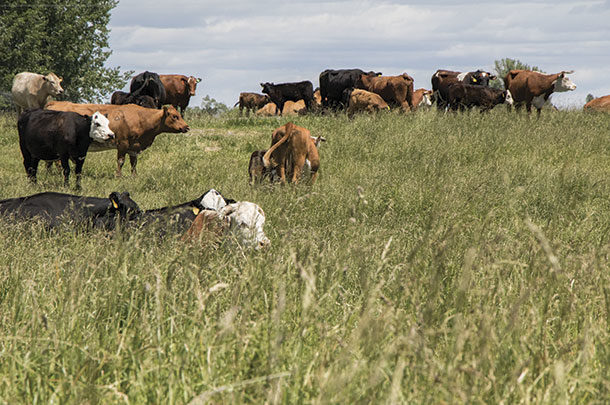Introduction and terminology
Rotational grazing (RG) has been promoted by many land-grant universities and USDA-NRCS for a number of years. Substantial research has shown rotational grazing to have many benefits, including improvements to soil fertility and health, reductions in hay feeding, increased stocking rates and greater profitability. Mob grazing (MOB) is a more intensive type of rotational grazing.
A MOB system is characterized by ultra-high stocking densities (greater than 100,000 pounds of bodyweight per acre), short durations (one day or less between rotations) and long rest periods (usually at least 45 days of growth). For example, a cattleman may have 200 heifers that each weigh 1,000 pounds on a 1-acre tall fescue-based paddock for eight hours (0.33 days), and those animals may not rotate back to this area for 60 days.
In this discussion, a MOB system is defined by the characteristics above, and an RG system refers to stocking densities less than 100,000 pounds of bodyweight per acre and one- to 20-day stays in a paddock before rotating to the next one. Rest period is left undefined, since it varies during the season and with forage species.
To present the subject, a shorthand notation that Dr. Woody Lane and I have developed (see Dr. Lane’s article in the June issue of Progressive Forage) will be used. For instance, the example of mob-grazed heifers mentioned above could be summarized with the shorthand MOB,0.33,200K (note the lack of spaces).
The first term (MOB) represents the system, the middle value indicates the fraction of a day or number of days the stock spend grazing a paddock and the last value indicates the stocking density. Similarly, a rotational grazing (RG) system where those same 200 heifers grazed a 10-acre, tall fescue-based paddock for three days before being rotated to the next 10-acre paddock could be described with the shorthand of RG,3,20K.
Forage and animal measures
Forage quality – One of the most frequent questions about mob grazing is the impact that those long rest periods have on forage maturity and, therefore, forage quality. In studies in Nebraska and Michigan, there was generally no consistent impact on forage quality in the spring and early summer. However, forage quality differences were more common in the latter half of the grazing season.
In Michigan, perennial cool-season grass pastures had forage up to 30 percent lower in protein and 15 percent lower in digestibility when managed under a MOB,0.33,100K system compared to an RG,1,30K system. Despite being lower in nutritive value, dry matter intake rates were similar in both systems.
Animal performance – Of course, a fundamental question is whether or not mob grazing impacts animal performance. In the cool-season grass pastures in the Michigan research, beef cow weights did not differ between MOB,0.33,100K and RG,1,30K systems. In a preliminary report on warm-season, grass-based pasture research in Arkansas, an RG,1,50K system – meant to represent a MOB-like system common in their region – resulted in a significant loss of body condition in cows compared to an RG,6,5K system.
However, they observed no significant differences in cow or calf weight and blood serum indicators of stress were also not different between the treatments. In contrast, researchers in Nebraska found that yearling steer gains averaged 0.4 pounds per head per day on a MOB,0.5,200K while an RG,10,5K system produced 1.5 pounds per head per day (Figure 1).
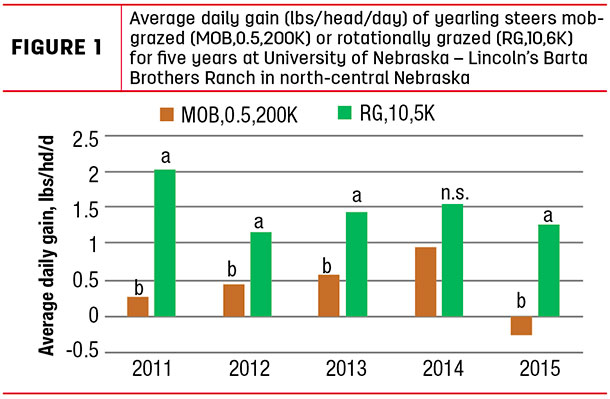
Animal activity – Researchers in Nebraska used pedometers similar to the fitness monitors that many people now wear on their wrists. They found that cattle grazing in a MOB,0.5,200K system took 5,551 steps per day, while cattle in an RG,15,7.5K took an average of 1,592 fewer steps each day. Their observation was that this was likely the result of having long (300 feet) and narrow (12 feet) rectangular paddocks where animals were stocked so densely they had to regularly move around other cattle to find enough forage.
In a follow-up study, they noted that square paddocks reduced the amount of walking in the MOB,0.5,200K system, but that there was still a significant increase in walking compared to the RG,15,7.5K.
Species shifts – Those who use mob grazing report significant shifts in the species that make up their pastures. Researchers have not consistently observed such shifts. There have been minor species shifts reported in Michigan, where they tended to lose shorter-growing grass and legume species in the MOB,0.33,100K relative to the RG,1,30K systems.
In both systems, they lost bluegrass from the mix. Reports out of Iowa where they compared two mob grazing intensities, MOB,0.25,500K and MOB,1,110K, also only found subtle shifts away from shorter-growing pasture species compared to a non-grazed control. Similar results were reported by researchers in Nebraska comparing a MOB,0.5,200K, an RG,15,7.5K and an RG,10,5K system.
Each of the researchers stated the variability in species diversity they observed seemed to have more to do with weather events than grazing management.
Consumption versus trampling – The efficiency of forage use is often the most hotly debated aspect between advocates for rotational and mob grazing. In Nebraska, the MOB,0.5,200K resulted in 56 percent of the forage being trampled while 33 percent disappeared (likely consumed; Figure 2). In contrast, the RG,10,5K system resulted in only 19 percent being trampled and 44 percent being consumed.
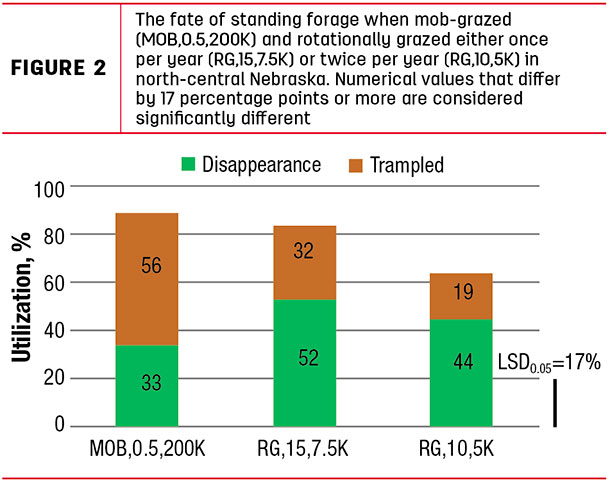
Similar reports came from the Michigan research. Additional research in Nebraska examined incremental increases in MOB stocking densities of up to 750,000 pounds of bodyweight per acre and found the rate of trampling did not increase at stocking densities greater than 100,000 pounds of bodyweight per acre.
Impacts on the soil
Soil temperature and moisture – Proponents of mob grazing have observed that the trampling of forage keeps the soil from heating up in the sun and helps to keep the soil from losing moisture. Research in Michigan, however, found that soil temperatures were lower and soil moisture was higher in the RG,1,30K relative to the MOB,0.33,100K systems.
Conclusions from their research must be drawn cautiously until more replications of these treatments can examine these effects over more soil types and landscape positions.
Mulch on the soil surface – With all that trampling of forage, one would assume that a mob system would result in more residue on the soil surface. However, work in Nebraska indicated that the MOB,0.5,200K resulted in an average of 2 percent loss in litter mass, which was similar to the non-grazed control.
Meanwhile, the RG,15,7.5K and RG,10,5K systems resulted in a 7 to 12 percent increase in residue on the soil surface (Figure 3).
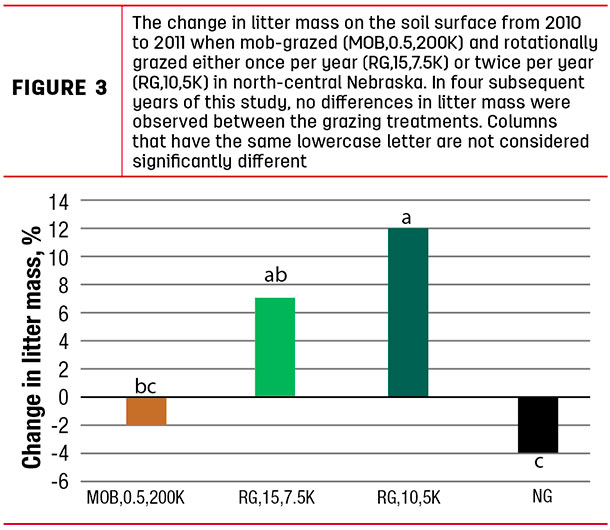
Measures of residue on the soil surface in the four subsequent years of that Nebraska trial showed no difference between treatments. They also found there was no increase in root production or litter decomposition rates between those grazing systems.
Soil compaction – With those ultra-high stocking densities, some worry that excessive soil compaction may occur as a result of the hoof traffic. Here again, the research does not provide clear answers. In an Iowa study, MOB,0.25,500K and MOB,1,110K systems resulted in no difference in penetrometer resistance (i.e., more soil compaction). In Michigan, soil compaction in the RG,1,30K treatment tended to be approximately 10 percent lower than in the MOB,0.33,100K system.
Soil organic matter – For those who practice mob grazing, one of the major reasons they give for employing the system is they want to improve soil organic matter (OM) and the biological activity of the soil. This is certainly a noble goal. But does mob grazing increase soil OM faster than the lower stocking densities in more common rotational grazing systems?
Very limited research data are available on this aspect, but the research in Michigan found that soil OM was higher in the RG,1,30K relative to the MOB,0.33,100K system at each increment in a 12-inch soil profile. Again, one should be cautious with conclusions until this research can be replicated across other soil types and landscape positions.
Still, it is worth noting that the rate of soil OM buildup in the soils where the RG,1,30K system was put in place are generally in line with the rate of soil OM increase we have observed on pasture-based dairies in Georgia. Those dairies typically operate a RG,1,50K system, and our on-farm research has repeatedly observed that soil OM increases at a rate of up to 0.30 to 0.33 percentage points each year for at least eight to 10 years after converting from cropland.
Greenhouse gas emissions
Carbon footprint – The discussion about soil OM buildup in the soil is a great segue into discussions about greenhouse gas emissions and the “carbon footprint” of these systems. The research in Michigan addressed this aspect in great detail.
Table 1 presents their estimates of greenhouse gas emissions from the pasture and from the livestock on an animal unit basis. The largest difference can be found in the amount of carbon dioxide, nitrous oxide and methane emissions from the soil on an animal unit basis.
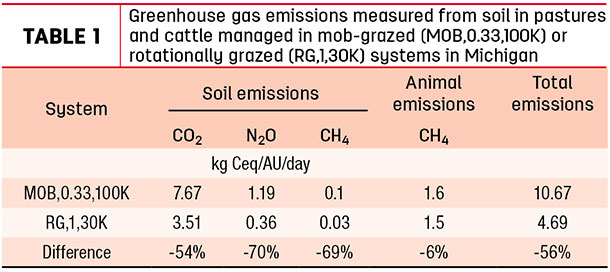
The greenhouse gas emissions from the soil of the RG,1,30K pastures were 50 to 70 percent less than the MOB,0.33,100K system per animal unit. This is largely because the RG,1,30K and MOB,0.33,100K systems in their experiment were different in the stocking rate.
True, the stocking density at any one point in time on the MOB,0.33,100K system had over three times more animals per acre on the areas being grazed than did the RG,1,30K system. But stocking density is not the same as stocking rate. The stocking rate over the whole season and across all of the grazeable acres in the RG,1,30K system was 250 percent higher than the MOB,0.33,100K system.
Methane emissions from animals in each system were not substantially different, but because more animals could be stocked on the RG,1,30K system, its total carbon footprint was over 50 percent less per animal production unit than the MOB,0.33,100K system.
Profitability
After all is said and done, no farm production system is sustainable if it is not profitable. Livestock economists from South Dakota State University examined the multiple years of production data from the grazing research in Nebraska to compare the average profitability of the MOB,0.5,200K, RG,15,7.5K and RG,10,5K systems (Table 2).
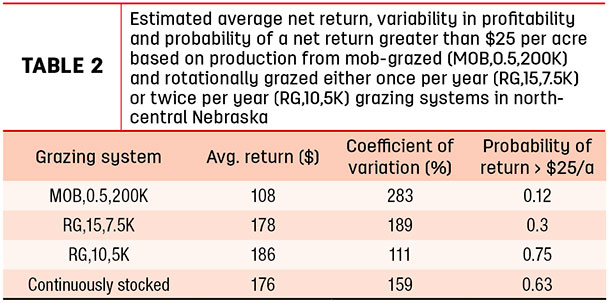
They found the MOB,0.5,200K system resulted in the lowest average net return and the most variability in profit from year to year. In their analysis, the most profitable and least variable system was the RG,10,5K grazing management. They estimated that approximately 75 percent of the time, producers operating an RG,10,5K system would have a net return greater than $25 per acre. In contrast, the probability of a net return greater than $25 per acre in the MOB,0.5,200K was estimated at 12 percent.
Weaknesses and data gaps
Grazing research is very challenging, and no study can answer all the questions. The research published to date is merely a good start. There is still a lot of research that needs to be done, and on-farm data collection should be a point of emphasis. Most comparisons have been conducted on cool-season, perennial grass-based pastures.
Only some of the research has used native grasses and only one has examined this practice on introduced warm-season perennial grasses. Grazing strategies that work in one area may not work well elsewhere.
More importantly, most of the studies to date set the stocking rate equal across treatments. Research has not yet determined if rotational and mob grazing management systems differ in their optimal stocking rates or in carrying capacity over the long run.
Fundamentally, the farmer or rancher needs to know what grazing management strategy will result in the most marketable product per acre while minimizing environmental impact and sustaining an enjoyable livelihood. As yet, the data are too sparse to conclude mob grazing will meet this goal. But all of the early evidence suggests that a well-managed rotational grazing system with frequent moves and moderate stocking densities is more likely to reliably meet this goal. ![]()
PHOTO: Grazing research is very challenging, and no study can answer all the questions. The research published to date is merely a good start. Photo by Lynn Jaynes.
A video of the full presentation is available on AFGC’s YouTube channel. The cited literature can be found in that video or downloaded here (Word online - literature cited) if one would like to dig deeper into the details. Please note that none of the data summarized on this subject is my own. In this article, I report only on the conclusions of others. If one has questions or comments about those conclusions, they should contact the authors of those studies.

-
Dennis Hancock
- Extension Forage Specialist
- University of Georgia
- Email Dennis Hancock
Resources
-
Mob Grazing: Facts, Fiction and Questions
- Mob Grazing: An Animal Scientist/Producer Perspective
- Mob Grazing: Tool or Toolbox?
